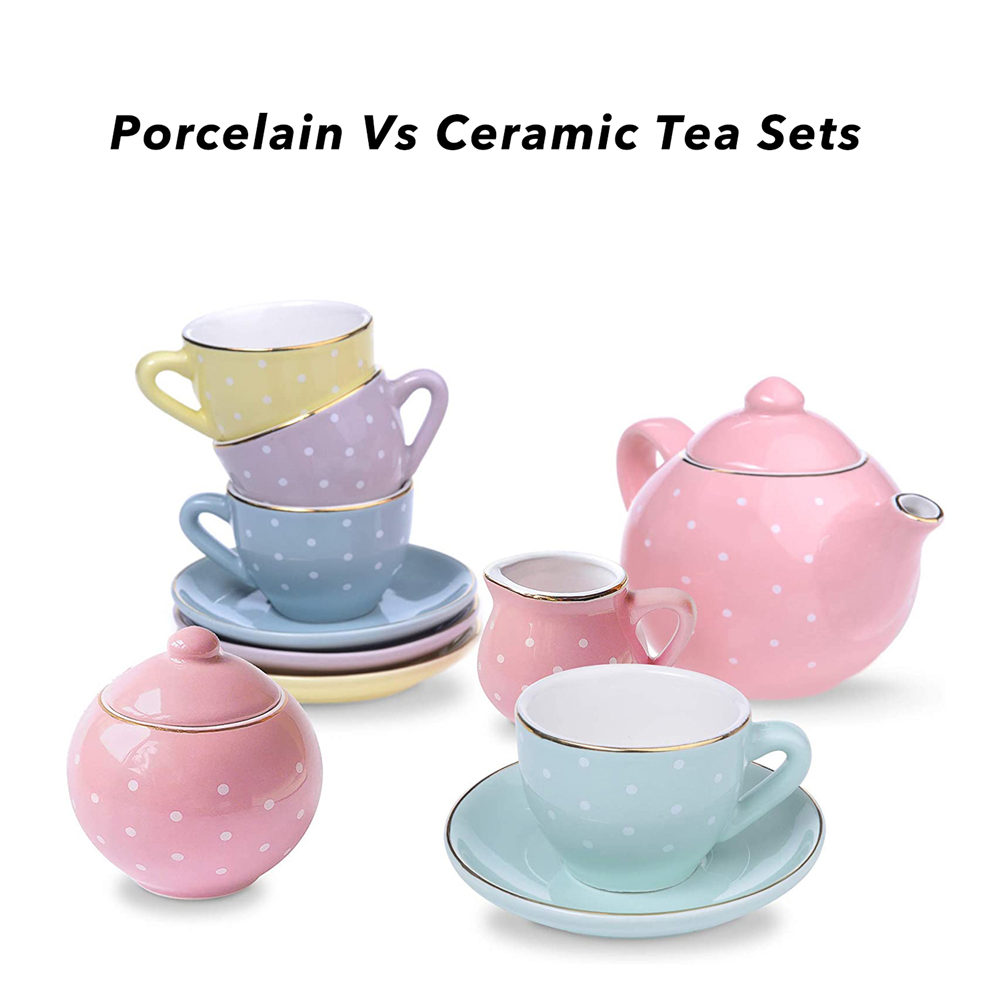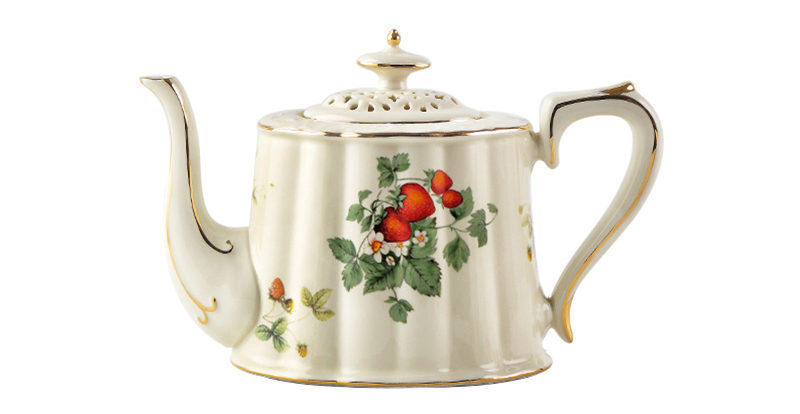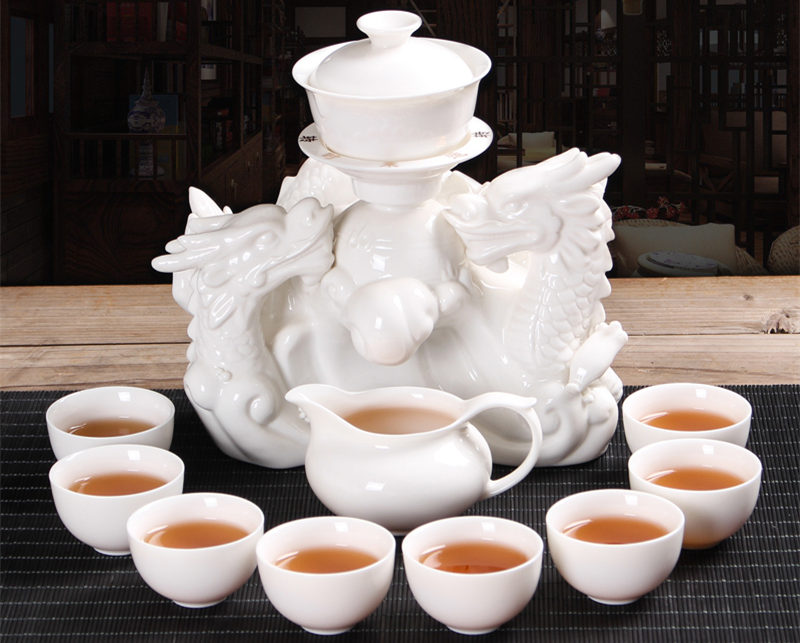Servizi da tè in porcellana vs. in ceramica
Ora di emissione: 2024-03-22 15:50:11
Introduzione:
Quando ci si abbandona al rituale del tè, il contenitore da cui lo si sorseggia può influenzare significativamente l'esperienza complessiva. Due opzioni popolari, i servizi da tè in porcellana e in ceramica , offrono qualità uniche che soddisfano preferenze ed esigenze diverse. In questo articolo, sveleremo le differenze tra i servizi da tè in porcellana e quelli in ceramica, aiutandovi a fare una scelta consapevole per migliorare i vostri momenti di degustazione del tè.
La storia del tè:
Secondo PEETS , la storia del tè iniziò nel 2737 a.C., quando l'imperatore Shen Nong, abile sovrano e scienziato, scoprì accidentalmente il tè. Mentre faceva bollire l'acqua in giardino, una foglia di un albero di tè selvatico che cresceva lì vicino cadde nella sua teiera. L'imperatore si divertì così tanto a bere l'acqua infusa che si sentì spinto a studiare ulteriormente la pianta. La leggenda narra che l'imperatore scoprì le proprietà medicinali del tè durante le sue ricerche.
Qualunque sia la leggenda, rintracciare le radici originali del tè si rivela difficile. È probabile che la pianta del tè abbia avuto origine nelle regioni della Cina sud-occidentale, del Tibet e dell'India settentrionale. I commercianti cinesi potrebbero aver viaggiato spesso attraverso queste regioni e incontrato persone che masticavano le foglie di tè per scopi medicinali.
Fu solo durante la dinastia Tang (618-907), spesso definita l'epoca classica del tè, che il consumo si diffuse. Una tassa sul tè imposta dal governo ne testimonia ulteriormente la crescente popolarità, e fu in questo periodo che il tè fu riconosciuto come bevanda nazionale cinese.
Durante la dinastia Tang, un monaco buddista, Lu Yu (733-804), compose il Ch'a Ching, o Classico del Tè. Descrisse i tipi di tè, i loro usi, la preparazione e i benefici del suo consumo. Ancora più importante, infuse negli scritti un'estetica spirituale che rifletteva il pensiero religioso buddista, taoista e confuciano dell'epoca. Questi insegnamenti erano incentrati su una tradizionale cerimonia del tè, che fungeva da metafora per esprimere l'armonia e la semplicità che non solo ordinavano, ma permeavano anche l'intero universo.
La ceramica è adatta al tè?
Nel mondo degli appassionati di tè, il contenitore in cui si prepara e si serve il tè gioca un ruolo cruciale nell'esperienza complessiva. La ceramica, rinomata per la sua resistenza e versatilità, è una scelta popolare per gli amanti del tè che desiderano elevare il proprio rituale di degustazione.
I vantaggi della ceramica per la preparazione del tè:
Mantenimento del calore: teiere e tazze da tè in ceramica sono eccellenti nel trattenere il calore, garantendo che il tè rimanga alla temperatura desiderata più a lungo. Questo è particolarmente vantaggioso per i tè che richiedono un'infusione a temperature specifiche per estrarne al meglio i sapori e gli aromi.
Even Heat Distribution: Ceramic's ability to distribute heat evenly throughout the vessel promotes uniform steeping, allowing the tea leaves to release their flavors and essences harmoniously. This results in a well-balanced and flavorful brew, enhancing the overall tea-drinking experience.
Neutral Taste: Unlike certain materials that may impart unwanted flavors or odors to the tea, ceramic is inert and does not alter the taste or aroma of the brewed tea. This purity allows the natural flavors of the tea leaves to shine through, ensuring a clean and authentic tea-drinking experience.
Versatility: Ceramic teapots and tea cups come in a wide range of styles, shapes, and designs, catering to diverse preferences and aesthetics. Whether you prefer classic elegance, modern simplicity, or artisanal craftsmanship, there's a ceramic tea vessel to suit your taste and complement your decor.
Considerations When Using Ceramic for Tea:
Fragility: While ceramic is durable and resistant to heat, it may be more prone to breakage or chipping compared to materials like glass or metal. Care should be taken when handling ceramic teapots and tea cups to prevent accidental damage.
Temperature Sensitivity: Ceramic may crack or shatter if exposed to sudden temperature changes, such as pouring boiling water into a cold teapot or placing a hot teapot on a cold surface. Preheating the teapot with warm water before brewing can help mitigate this risk.
What Is The Difference Between Porcelain And Ceramic Tea Sets?
Porcelain Tea Sets:
Renowned for their elegance and refinement, porcelain tea sets exude delicate beauty and sophistication. Crafted from a specialized ceramic material known as porcelain, these sets boast translucency, a smooth texture, and exquisite craftsmanship. Porcelain is formed by firing specific clay types at high temperatures, resulting in a vitreous, non-porous material prized for its durability and aesthetic appeal.
Key among the attributes of porcelain tea sets is their exceptional heat retention, making them ideal for serving piping hot tea. The thin walls of porcelain cups and teapots facilitate even heat distribution, ensuring that your tea remains warm for extended periods. Furthermore, porcelain's smooth surface is effortless to clean and resistant to staining, rendering it a practical choice for daily use.
Porcelain tea sets often feature intricate patterns, delicate motifs, and subtle embellishments that enhance their allure. Ranging from classic floral designs to modern minimalist styles, porcelain tea sets cater to diverse tastes and aesthetic preferences.
Ceramic Tea Sets:
Ceramic tea sets offer a more versatile and eclectic approach to tea enjoyment. Crafted from various clay types and fired at lower temperatures than porcelain, ceramic tea sets exhibit a broad spectrum of styles, colors, and finishes. Ceramic is a broad term encompassing different clay-based materials such as earthenware, stoneware, and bone china.
A primary advantage of ceramic tea sets lies in their durability and resilience. Unlike porcelain, which may be brittle and prone to chipping, ceramic tea sets are often sturdier and less susceptible to breakage. This makes them an excellent choice for everyday use, especially in households with children or pets.
Moreover, ceramic tea sets offer greater design versatility, ranging from rustic farmhouse aesthetics to contemporary geometric patterns. Ceramic's porous nature enables creative glazing techniques, resulting in unique textures and finishes that imbue each piece with character and charm.
Porcelain vs. Ceramic
In the perennial debate between porcelain and ceramic tea sets, there is no clear winner?only a reflection of individual preferences, aesthetic sensibilities, and cultural influences. Whether you gravitate towards the timeless elegance of porcelain or the rustic charm of ceramic, both materials offer unique qualities that enrich the tea-drinking ritual in their own way.
For those who value refinement and sophistication, porcelain tea sets present an unparalleled option, with their luminous translucency, delicate appearance, and heat-retaining properties. Ideal for showcasing intricate designs and vibrant colors, porcelain exudes an air of timeless elegance that elevates the tea-drinking experience to new heights.
On the other hand, ceramic tea sets appeal to those who appreciate tradition, craftsmanship, and the inherent warmth of earthy materials. With their diverse range of styles and textures, ceramic vessels offer endless possibilities for creative expression, allowing tea enthusiasts to imbue their rituals with personal meaning and character.
England Tea Set Vs Kung Fu Tea Sets
Within the intricate world of tea culture, the vessel one chooses to drink from carries profound significance, reflecting not only tradition but also the nuanced artistry of tea-drinking rituals. Among the diverse array of tea sets available, the shapes of English tea sets and the covered tea bowls of Kung Fu tea sets stand out as emblematic representations of their respective cultures and customs. Delving into the shapes of these vessels unveils intriguing distinctions that contribute to the overall tea-drinking experience.
The Classic Elegance of English Tea Set Shapes

The shapes of English tea sets evoke a sense of timeless elegance and refined sophistication, embodying centuries of tradition and cultural heritage. Each component of an English tea set?from the teapot to the cups and saucers?is meticulously designed to harmonize form with function, creating a visually pleasing and practical ensemble.
In un set da tè inglese, la teiera vanta tipicamente un corpo arrotondato con un beccuccio elegantemente curvato e un manico robusto, che facilita il versamento senza sforzo. Questa forma tradizionale non solo garantisce un'efficiente preparazione e servizio del tè, ma emana anche un senso di elegante equilibrio e un fascino discreto.
Al contrario, le ciotole da tè con coperchio dei set da tè Kung Fu aderiscono a un design estetico e funzionale diverso. Radicate nella filosofia del Gong Fu Cha, l'arte della preparazione del tè, le ciotole da tè Kung Fu sono realizzate con attenzione e precisione, dando priorità alla funzionalità e all'esperienza sensoriale del bere il tè.
La semplicità funzionale dei set da tè Kung Fu

Nei set da tè Kung Fu, le ciotole con coperchio sono fondamentali per la pratica del Gong Fu Cha, incarnando semplicità, funzionalità e ricerca dell'armonia. Queste ciotole con coperchio sono progettate per migliorare la preparazione e il servizio del tè, offrendo un contenitore che cattura l'essenza di ogni infusione, preservandone calore e aroma.
Le ciotole da tè Kung Fu presentano in genere una forma tozza e arrotondata, con un'ampia apertura e un coperchio aderente. Questo design consente un'ottimale ritenzione del calore e un'ottima infusione, garantendo che le foglie di tè si aprano e rilascino tutto il loro sapore e aroma all'interno dello spazio racchiuso della ciotola.
Il coperchio di una ciotola da tè Kung Fu ha una duplice funzione: trattiene il calore e l'aroma all'interno della ciotola durante l'infusione e funge anche da filtro, consentendo di versare il tè senza sforzo, trattenendo eventuali foglie o sedimenti. Questa meticolosa attenzione ai dettagli riflette l'arte e la precisione del Gong Fu Cha, dove ogni aspetto del processo di degustazione del tè è attentamente considerato ed eseguito con cura.
Conclusione
Nel vasto e affascinante regno della cultura del tè, la scelta tra servizi da tè in porcellana e in ceramica non è solo una questione di praticità o estetica, ma riflette il gusto personale, il patrimonio culturale e la ricerca senza tempo di bellezza e raffinatezza. Che siate attratti dalla delicata eleganza della porcellana o dal fascino rustico della ceramica, entrambi i materiali offrono esperienze ricche e appaganti che esaltano il rituale del tè in modi unici.
Quindi, la prossima volta che vi imbarcherete in un viaggio all'insegna del tè, prendetevi un momento per apprezzare il contenitore da cui lo sorseggiate: la sua artigianalità, la sua storia e le sottili sfumature che lo rendono davvero speciale. Che sia in porcellana o in ceramica, lasciate che vi ricordi il ricco arazzo della cultura del tè e la gioia senza tempo di condividere un semplice piacere con gli altri.
POST RECENTI
- Dovresti conservare l'olio d'oliva in frigorifero? La verità che devi sapere!
2025-04-18
- Qual è la dimensione standard del piatto da insalata? Trova la soluzione migliore
2025-04-18
- I migliori tipi di vasi spagnoli che raccontano una bella storia
2025-03-31
- Le 5 migliori scatole portagioielli che amerai esporre
2025-03-31
- Come riparare una tazza in ceramica? Dai una seconda vita alla tua tazza.
2025-03-11
- Le tazze in ceramica sono lavabili in lavastoviglie? Sfatiamo alcuni miti
2025-03-11
- I 12 migliori oli profumati per bruciatori di oli [2025]
2025-02-06
- Scatole per gioielli all'ingrosso: stili, materiali e opzioni personalizzate
2025-02-06
Hai bisogno di un preventivo?Hai domande?
Ricevi una risposta da un esperto entro 24 ore
PARLA CON UNO SPECIALISTA >








